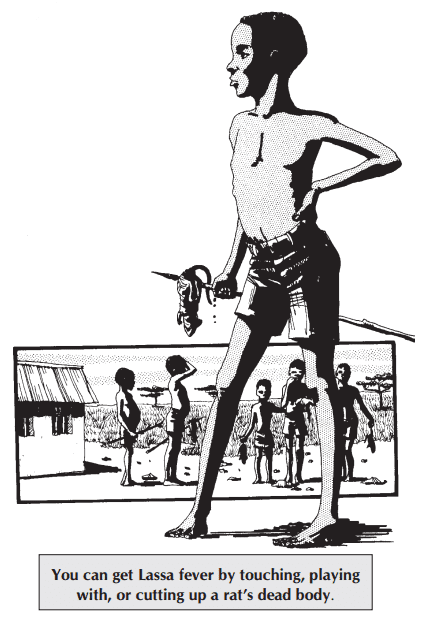Patrick Ashinze
Irrua, Edo State, Nigeria

Little has been written about Lassa, a small town plagued by terrorism in northeastern Nigeria. No one has published even a cursory description of its topography or demography, its markets, schools, infrastructure, or the people who come from it. It is now known only as the site of origin of one of the most formidable viral hemorrhagic fevers in human history.
It all began in January 1969. Nurse Laura Wine, a cheerful, motherly, retired Chicagoan nurse, then in charge of the obstetrics unit at Lassa General Hospital, had just ended a vacation in the United States1,2 and had made a brief stop in Sierra Leone before returning to Nigeria. She was sixty-nine years old, a missionary nurse affiliated with the Church of the Brethren, and she was running a fever.3 In the past she had suffered from malaria, but this was different, distressing, and worsening as the days passed. At last she was referred to a better equipped hospital.1,2
All treatments, however, were of no avail, and she died. It soon became clear that this disease was something new and not seen before. It was obviously highly contagious and dangerous, as not long after, some who came in contact with her, including her caregivers, also died.2,3 The disease has also been observed in several other African countries and has claimed many victims. It became known as Lassa fever, so named by the US Centers for Disease Control in the early 1970s.
Giving it this name had severe consequences for the small town of Lassa.4 It soon became a pariah, a wasteland. Physicians began to decline transfers there, travelers stopped coming, and even missionaries were apprehensive to work there.3,4 In an attempt at damage control, the Nigerian government fought back at the World Health Organization assembly for implicating Lassa in the damning nomenclature. But by then, the damage could not be undone. Once an organism is named in the scientific literature, changing that name is next to impossible.2 The name “Lassa fever” had come to stay.
Lassa fever is a zoonotic (animal-borne) acute viral hemorrhagic illness spread by the common African multimammate rat (Mastomys natalensis).4,5 It is found in such West African nations as Sierra Leone, Liberia, Guinea, and in Nigeria, where the region’s foremost research institute for viral hemorrhagic fevers and emergent pathogens is located. Because the animal vector lives throughout the region, neighboring countries are also at risk. Lassa fever, like Ebola in its most severe form, causes bleeding from the mouth, nose, and stomach. However, it is less contagious and less lethal than its infamous counterpart. Around 80% of infected people have no symptoms, and those who do experience mild symptoms develop the typical viral symptoms of fever, vomiting, fatigue, and aches.5 Worryingly, one-quarter of survivors become deaf, though half of those regain some hearing. Early presentation makes recovery easier and faster, and the advent of the radical antiviral drug ribavirin has greatly reduced the mortality rate. There is no vaccine yet, although there are potential candidates.6
But, barring a miracle, the small town of Lassa will never again appear innocuous whenever it is mentioned or visited by outsiders.
References
- Young, Ed. “Why is Nigeria Experiencing a Record-High Outbreak of Lassa Fever?” The Atlantic, February 28, 2018. https://theatlantic.com/health/archive/2018/02/nigeria-lassa-fever-outbreak-emerging-diseases/554528/.
- Mamadu, Ibrahim. “How ‘Lassa’ a small Nigerian town was stigmatized by having a killer virus named after it.” Nigeria Health Watch, January 24, 2018. https://articles.nigeriahealthwatch.com/how-lassa-went-from-a-small-nigerian-town-to-a-well-known-virus/.
- “A History of the Church of the Brethren Mission in Nigeria and the Emergence of Ekklesiyar Yan’uwa a Nigeria, part 4.” Church of the Brethren. https://brethren.org/global/nigeria/history4/.
- “Lassa Fever.” Centers for Disease Control and Prevention, last reviewed April 26, 2022. https://cdc.gov/vhf/lassa/index.html.
- “Lassa fever.” World Health Organization. https://who.int/health-topics/lassa-fever.
- Geisbert, Thomas, et al. “Development of a New Vaccine for the Prevention of Lassa Fever.” PLOS Medicine vol. 2, no. 6 (2005): e183. doi:10.1371/journal.pmed.0020183.
PATRICK ASHINZE is a medical graduate from the University of Ilorin, Nigeria in 2021. He has written for national and international publications and has won awards for his poetry, prose, essays, reviews, and research writing. A decorated youth leader and serial social innovator, he currently resides and practices at the Irrua Specialist Teaching Hospital, Edo State, Nigeria.
Submitted for the 2022–23 Medical Student Essay Contest and Highlighted in Frontispiece Volume 15, Issue 3 – Summer 2023

Leave a Reply